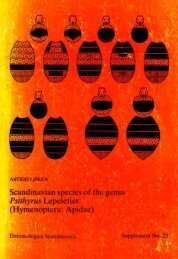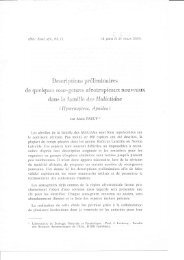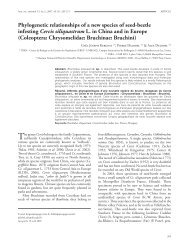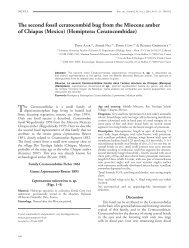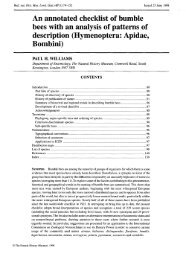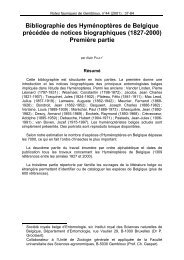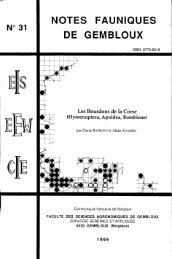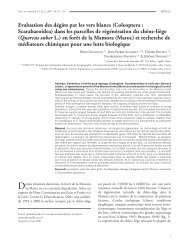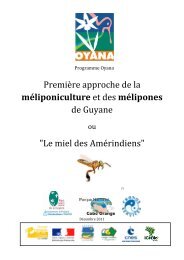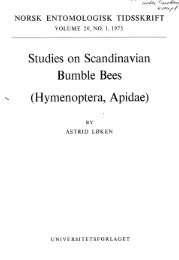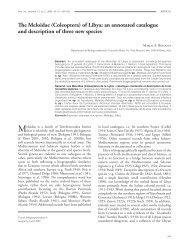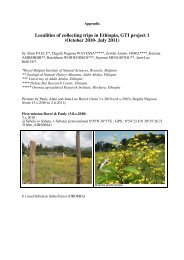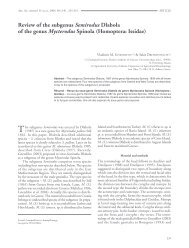New griffenfly, Bohemiatupus elegans from the Late Carboniferous ...
New griffenfly, Bohemiatupus elegans from the Late Carboniferous ...
New griffenfly, Bohemiatupus elegans from the Late Carboniferous ...
Create successful ePaper yourself
Turn your PDF publications into a flip-book with our unique Google optimized e-Paper software.
<strong>New</strong> <strong>Late</strong> <strong>Carboniferous</strong> <strong>griffenfly</strong> in western Bohemianear <strong>the</strong> Permian genus Tupus Sellards 1906 becauseof <strong>the</strong> following characters: <strong>the</strong> two braces CuP andCuA oblique, not fused into a long, oblique vein; AA1with several posterior branches; and CuP with morethan three concave branches. <strong>Bohemiatupus</strong> n. gen.greatly differs <strong>from</strong> Tupus in its hindwing cubito-analarea distinctly broader than that of fore wing. Some‘enigmatic’ genera are based on incomplete wings, i.e.<strong>the</strong> <strong>Carboniferous</strong> genera Shenzhousia Zhang et al.2006 and Boltonites Handlirsch 1919, and <strong>the</strong> PermianPetrotypus Zalessky 1950. Petrotypus needs a completeredescription, and it is based on a very poor fossil.Never<strong>the</strong>less, its CuP seems to be simple and verystraight after Zalessky (1950), unlike <strong>Bohemiatupus</strong> n.gen. Shenzhousia shares with <strong>Bohemiatupus</strong> n. gen. avery long and straight CuP but with numerous posteriorbranches covering a broad area, unlike <strong>Bohemiatupus</strong>n. gen. (Zhang et al. 2006). After <strong>the</strong> figure of Bolton(1922: fig. 44), Boltonites has a distinctly curved CuP,shorter than that of <strong>Bohemiatupus</strong>.Conclusions<strong>Bohemiatupus</strong> n. gen. is established for <strong>Bohemiatupus</strong><strong>elegans</strong> n. sp. (type species) that exhibits uniquecombination of characters within Meganeuridae. Thepresent discovery represent <strong>the</strong> first record of large<strong>griffenfly</strong> <strong>from</strong> <strong>the</strong> continental basins of <strong>the</strong> BohemianMassif supplementing <strong>the</strong> o<strong>the</strong>r giant insects suchas Bojophlebia prokopi Kukalová-Peck 1985 orCarbotriplura kukalovae Kluge 1996 <strong>from</strong> <strong>the</strong> samestrata.Moreover, <strong>the</strong> material <strong>from</strong> Ovčín near Radnicerepresents an extraordinary source of fossil plants in situand o<strong>the</strong>r animals like arachnid, fish and amphibiantrace fossils those enable study of developed peatmire ecosystem into a shallow lake gradually filled byredeposited volcanic ash <strong>from</strong> Bolsovian of westernBohemia (Czech Republic).Acknowledgements. The authors are grateful to Radek Labuťa(National Museum in Praha) who discovered <strong>the</strong> present specimenand to group of <strong>the</strong> Czech paleobotanits so called “Czechmafia” for large excavations at Ovčín locality. We especiallythank to Josef Pšenička (West Bohemian Museum in Plzeň) for<strong>the</strong> loan of <strong>the</strong> material. The first author (JP) acknowledges <strong>the</strong>research support <strong>from</strong> <strong>the</strong> Grant Agency of Academy of <strong>the</strong>Czech Republic No. KJB301110701 and Ministry of SchoolsMSM 0021620828. We sincerely thank Dr Gun<strong>the</strong>r Fleck forhis useful comments on <strong>the</strong> first version of <strong>the</strong> paper.ReferencesBechly G. 1996. Morphologische Untersuchungen am Flügelgeäder derrezenten Libellen und deren Stammgruppenvertreter (Insecta; Pterygota;Odonata), unter besonderer Berücksichtigung der PhylogenetischenSystematik und des Grundplanes der Odonata. Petalura BöblingenSpecial Volume 2: 1-402.Bechly G. 2007. Phylogenetic systematics of Odonata. Homepage on Internet.http://www.bernstein.naturkundemuseum-bw.de/odonata/index.htmBechly G., Brauckmann C., Zessin W., Gröning E. 2001. <strong>New</strong> results concerning<strong>the</strong> morphology of <strong>the</strong> most ancient dragonflies (Insecta: Odonatoptera)<strong>from</strong> <strong>the</strong> Namurian of Hagen-Vorhalle (Germany). Zeitschriftfür Zoologische Systematik und Evolutionsforschung 39: 209-226.Bolton H. 1922. A monograph of <strong>the</strong> fossil insects of <strong>the</strong> British coalmeasures. Palaeontographical Society Monograph London 74: 81-156.Brauckmann C., Zessin W. 1989. Neue Meganeuridae aus dem Namuriumvon Hagen-Vorhalle (BDR) und die Phylogenie des Meganisoptera.Deutsche Entomologische Zeitschrift (N.F.) 36: 177-215.Carpenter F. M. 1939. The Lower Permian insects of Kansas. Part 8. AdditionalMegasecoptera, Protodonata, Odonata, Homoptera Psocoptera,Plecoptera, and Protoperlaria. Proceedings of <strong>the</strong> American Academy ofArts and Sciences 73: 29-70.Carpenter F. M. 1947. Lower Permian insects <strong>from</strong> Oklahoma. Part 1. Introductionand <strong>the</strong> orders Megasecoptera, Protodonata, and Odonata.Proceedings of <strong>the</strong> American Academy of Arts and Sciences 76: 25-54.Fritsch A. 1880. Dva noví členovci z útvaru kamanouhelného v Čechách [Twonew arthropods <strong>from</strong> <strong>the</strong> coal system in Bohemia.]. Vesmir 9: 241-242.Fritsch A. 1901. Fauna der Gaskohle und der Kalksteine der PermformationBöhmens. Bd. IV, Prag, 92 pp.Handlirsch A. 1920. Beiträge zur Kenntnis der Palaeozoischen Blattarien.Sitzungberichte der Akademie der Wissenschaften, Ma<strong>the</strong>matisch-Naturwissenschaftliche Klasse, Wien, (1), 129: 8.Jarzembowski E. A., Nel A. 2002. The earliest damselfly-like insect and <strong>the</strong>origin of modern dragonflies (Insecta: Odonatoptera: Protozygoptera).Proceedings of <strong>the</strong> Geologist’s Association 113: 165-169.Kukalová J. 1955. Permoedischia n. gen. (Protorthoptera) a Moravipteran. gen. (Palaeodictyoptera) z moravskeho permu. Sborník ÚstředníhoÚstavu Geologického, oddil Paleontologický 21: 541-575.Kukalová J. 1958. Paoliidae Handlirsch (Insecta, Protorthoptera) aus demOberschlesichen Steinkohlenbecken. Geologie 7: 935-959.Kukalová-Peck J. 1985. Ephemeroid wing venation based upon new gigantic<strong>Carboniferous</strong> mayflies and basis morphological phylogeny andmetamorphosis of pterygopte insects (Insecta, Ephemerida). CanadianJournal of Zoology 63: 933-955.Kušta J. 1883. Über einige neue böhmische Blattinen. Sitzungberichte KoniglicheBöhmische Gesellschaft Wissenschaften, Pragae 1883: 211-215.Libertín M., Opluštil S., Pšenička J., Bek J., Sýkorová I., Dašková J.2009. Middle Pennsylvanian pioneer plant assemblage buried insitu by volcanic ash-fall, central Bohemia, Czech Republic. Review ofPalaeobotany and Palynology 155(3-4): 204-233.Nel A., Garrouste R., Roques P. 2008. A new <strong>griffenfly</strong> genus <strong>from</strong> <strong>the</strong><strong>Late</strong> <strong>Carboniferous</strong> of nor<strong>the</strong>rn France (Odonatoptera: Meganeuridae).Insect Systematics & Evolution 39: 231-239.Nel A., Fleck G., Garrouste R., Gand G., Lapeyrie J., Bybee S. M.,Prokop J. 2009. Revision of Permo-<strong>Carboniferous</strong> griffenflies (Insecta:Odonatoptera: Meganisoptera) based upon new species andredescription of selected poorly known taxa <strong>from</strong> Eurasia. Palaeontographica(A) 289: 89-121.Nel A., Martínez-Declòs X., Paicheler J.-C., Henrotay M. 1993. Les‘Anisozygoptera’ fossiles. Phylogénie et classification (Odonata).Martinia Numéro Hors Série 3: 1-311.Novák O. 1880. Ueber Gryllacris Bohemica, einen neuen Locustiderenrestaus der Steinkohlenformation von Stradonitz in Böhmen. Jahrbuch derk.k. Geologischen Reichsanstalt 30: 69-75.Opluštil S., Pšenička J., Libertín M., Šimůnek Z. 2007. Vegetationpatterns of Westphalian and Lower Stephanian mire assemblages preservedin tuff beds of <strong>the</strong> continental basins of Czech Republic. Reviewof Palaeobotany and Palynology 143: 107-154.Opluštil S., Pšenička J., Libertín M., Bashforth A. R., Šimůnek Z.,Drábková J., Dašková J. 2009. A Middle Pennsylvanian (Bolsovian)peat-forming forest preserved in situ in volcanic ash of <strong>the</strong> WhetstoneHorizon in <strong>the</strong> Radnice Basin, Czech Republic. Review of Palaeobotanyand Palynology, 155 (3-4): 234-274.187



